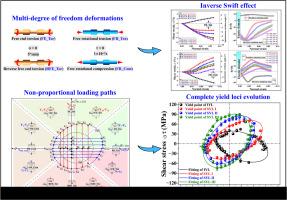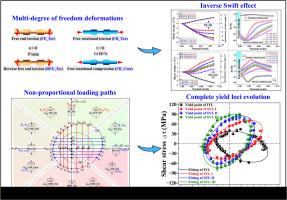Anisotropic yield loci and inverse Swift effect in extruded AZ31 Mg alloy under multi–degree-of-freedom torsional–axial non-proportional loading paths
IF 12.8
1区 材料科学
Q1 ENGINEERING, MECHANICAL
引用次数: 0
Abstract
The deformation mechanisms of Mg alloy under multi–degree-of-freedom axial, torsional, and combined loadings remains critically unclear. This is particularly significant in the case of the anisotropic evolution of yield loci and inverse Swift effect, which are crucial for optimizing the forming technologies for engineering parts. In order to clarify the underlying deformation mechanisms, combined multi–degree-of-freedom axial–torsional non-proportional loading paths are specially designed. The anisotropic evolution of the yield loci and Swift–inverse Swift effects in extruded AZ31 Mg alloys are investigated. The strong loading-path–dependent twinning activities and underlying deformation mechanisms are clarified in detail. The findings reveal that the inverse Swift effect during free rotational tension (FR_Ten) is attributed to the residual shear stress and initial texture heterogeneity, while the spontaneous macroscopic rotation during free rotational compression (FR_Com) is found to originate from the heterogeneous local strain induced by the interactions of the twins. Free end torsion (FE_Tor) pre-straining induces subsequent yield locus (SYL) rotation towards the positive τ axis and expansion along the negative σ axis. The anisotropic Swift–inverse Swift effects are accurately captured by the plastic strain-components on the yield loci. Tensile twinning and basal slip coordinate the plastic deformation under FR_Com-dominated loading paths, owing to the low twin favourability, and the relative activities of non-basal slips under FR_Ten-dominated loading paths are significantly improved. The evolutions of the Swift–inverse Swift effects are determined by elastic pre-loadings, resulting in loading–path-dependent anisotropic evolutions of mechanical responses.


多自由度扭轴非比例加载路径下挤压AZ31镁合金各向异性屈服轨迹及逆斯威夫特效应
镁合金在多自由度轴向、扭转和复合载荷作用下的变形机制尚不清楚。这在屈服轨迹的各向异性演化和逆斯威夫特效应的情况下尤为重要,这对优化工程零件的成形技术至关重要。为了弄清潜在的变形机理,设计了多自由度轴扭非比例加载路径。研究了挤压AZ31镁合金屈服位点的各向异性演化和Swift逆效应。详细阐明了强加载路径相关的孪生活动和潜在的变形机制。结果表明,自由旋转拉伸期间的逆Swift效应(FR_Ten)归因于残余剪切应力和初始织构异质性,而自由旋转压缩期间的自发宏观旋转(FR_Com)源于{101¯2}孪晶相互作用引起的非均质局部应变。自由端扭转(FE_Tor)预应变诱导屈服轨迹(SYL)沿正τ轴旋转和负σ轴膨胀。屈服轨迹上的塑性应变分量准确地捕捉了各向异性斯威夫特-逆斯威夫特效应。拉伸孪晶和基底滑移在fr_com主导加载路径下协调塑性变形,由于孪晶有利度较低,非基底滑移在fr_10主导加载路径下的相对活性显著提高。斯威夫特-逆斯威夫特效应的演化是由弹性预加载决定的,导致力学响应的各向异性演化依赖于加载路径。
本文章由计算机程序翻译,如有差异,请以英文原文为准。
求助全文
约1分钟内获得全文
求助全文
来源期刊

International Journal of Plasticity
工程技术-材料科学:综合
CiteScore
15.30
自引率
26.50%
发文量
256
审稿时长
46 days
期刊介绍:
International Journal of Plasticity aims to present original research encompassing all facets of plastic deformation, damage, and fracture behavior in both isotropic and anisotropic solids. This includes exploring the thermodynamics of plasticity and fracture, continuum theory, and macroscopic as well as microscopic phenomena.
Topics of interest span the plastic behavior of single crystals and polycrystalline metals, ceramics, rocks, soils, composites, nanocrystalline and microelectronics materials, shape memory alloys, ferroelectric ceramics, thin films, and polymers. Additionally, the journal covers plasticity aspects of failure and fracture mechanics. Contributions involving significant experimental, numerical, or theoretical advancements that enhance the understanding of the plastic behavior of solids are particularly valued. Papers addressing the modeling of finite nonlinear elastic deformation, bearing similarities to the modeling of plastic deformation, are also welcomed.
 求助内容:
求助内容: 应助结果提醒方式:
应助结果提醒方式:


